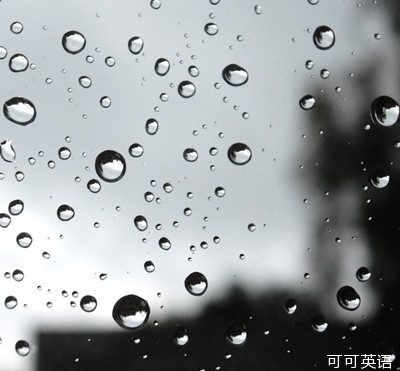(单词翻译:单击)
When it's raining, it may seem that every raindrop is the same—same size, same basic shape, same wetness. But if you could compare and measure raindrops, you'd find that they're not all the same size or shape. In fact, raindrops vary from one to six millimeters in diameter and come in all sorts of shapes. When they first fall from clouds, raindrops are surprisingly large—in rare cases, some are as wide across as a baseball. So what happens to break these monster drops into many smaller drops of different sizes?
下雨时,似乎每一滴雨都是一样的——一样的大小,一样的基本形状,一样的湿润。但如果你能比较和测量雨滴,就会发现它们的大小、尺寸并不完全相同。实际上,雨滴的直径从一毫米到六毫米不等,形状和尺寸也各不相同。当雨滴第一次从云端落下时,它们出奇的大——在很少见的情况下,某些雨滴甚至会宽如棒球。那么是什么让这些“怪兽”雨滴破碎成许多大小不一的小雨滴呢?

Scientists used to think it was the result of drops colliding and splintering as they fell. But one study has found that although individual large drops do indeed break up into smaller shards, it has nothing to do with mid air collisions. Instead, drops shatter all on their own. French scientists observed the phenomenon when they used a high speed camera to capture drops falling from a nozzle to simulate rainfall.
过去,科学家认为这是由雨滴在下落过程中相互碰撞、不断分裂所致。但一项研究发现,大雨滴确实分裂成为较小的碎片,但这与半空中的碰撞无关。实际上,雨滴是自动破裂的。法国科学家观察到这一现象,他们用喷嘴模拟降雨,用高像素的相机捕捉到了水滴下落时的镜头。
As it falls from the nozzle or cloud, the drop flattens. Then it seems to inflate like a balloon. Finally, after a few milliseconds, the upward pressure of air causes the drop to explode into hundreds of watery bits. The researchers created mathematical models to demonstrate that the shattering of individual drops explains why raindrops come in different sizes. Now, math is always useful—but to really get a sense of how raindrops shatter, you have to see it up close.
随着水滴从喷嘴或云端不断下降,雨滴趋于平缓。然后,它们像气球一样膨胀。最后,几毫秒过后由于空气的上行压力,雨滴爆炸成上百个小水滴。单个雨滴的爆炸解释了为什么雨滴的大小各异,研究人员还创建了数学模型来加以说明。现在,数学总是能派上用场——但想要真正了解雨滴是如何分裂的,你必须近距离观察它。
原文译文属可可原创,未经允许请勿转载!


